ARTH101 Study Guide
| Site: | Saylor Academy |
| Course: | ARTH101: Art Appreciation |
| Book: | ARTH101 Study Guide |
| Printed by: | Guest user |
| Date: | Friday, February 4, 2022, 8:35 AM |
Table of contents
- Navigating this Study Guide
- Unit 1: Defining Art
- Unit 2: Who Makes Art – Process and Training
- Unit 3: How Art Speaks – Finding Meaning
- Unit 4: How Art Works – The Elements and Principles of Visual Language
- Unit 5: Artistic Media
- Unit 6: Architecture
- Unit 7: Our World – Nature, the Body, Identity, Sexuality, Politics, and Power
- Unit 8: Other Worlds – Myths, Dreams, and Spirituality
- Unit 9: Art in Time and Place – The Western World
Navigating this Study Guide
Study Guide Structure
In this study guide, the sections in each unit (1a., 1b., etc.) are the learning outcomes of that unit.
Beneath each learning outcome are:
- questions for you to answer independently;
- a brief summary of the learning outcome topic; and
- and resources related to the learning outcome.
At the end of each unit, there is also a list of suggested vocabulary words.
How to Use this Study Guide
- Review the entire course by reading the learning outcome summaries and suggested resources.
- Test your understanding of the course information by answering questions related to each unit learning outcome and defining and memorizing the vocabulary words at the end of each unit.
By clicking on the gear button on the top right of the screen, you can print the study guide. Then you can make notes, highlight, and underline as you work.
Through reviewing and completing the study guide, you should gain a deeper understanding of each learning outcome in the course and be better prepared for the final exam!
Unit 1: Defining Art
1a. Distinguish between the form and content of an artwork
- How does art address our senses and minds differently?
- What aspects of art can be analyzed comparatively regardless of which artist or culture produced it?
- What shapes our interpretation of art?
Broadly, our understanding of art and how we explain it consists of a few qualities. First are the descriptions and analyses of a work of art's features. Those are either based on the perceptual qualities of the artwork (such as the colors, shapes or contrasts employed in the composition), as well as the material they're made of and the methods used to produced them. Second, there are interpretive aspects that are informed by culture, and these interpretations can be unique to a given person, group, or society. Since humans perceive art very similarly across most populations (by using their eyes and ears), there can be quite broad agreement as to the perceptual and material aspects of art, since these can be objectively verified.
However, interpretations of art can be also be subjective. Art is often controversial, mysterious, socially significant, or personal. These interpretations depend on other factors, such as the cultural background of the artist or viewer, the use of symbolic material, or the artistic consumption habits of its audience. The perceptual and material dimensions (the objective aspects) of an artwork are described as its "form", whereas the interpretive (subjective) components are its "content". These categories, form and content, derive from Greek antiquity, where philosophers made the distinction between what something says (the content), and how something is said (its form).
Example:
In this image, a formal aspect of the image is that it is a triptych, meaning an image composed out of three frames aligned side-by-side. An aspect of content is that one needs to know something about important figures in Christianity as the image depicts, in order of left to right: John the Baptist, the Virgin Mary, Jesus, St. John the Evangelist, and Mary Magdalene.

To review, read Form and Content.
1b. Explain aesthetics and the role it plays in different cultural conventions and perspectives
- What field of general intellectual endeavor does aesthetics belong to?
- What kinds of questions are asked by aesthetics?
- How does on articulate aesthetic insights?
It is hard to separate art from conversations about it, which are also called the "discourses" of art. Art is saturated with concepts, histories, schools and movements, linkages to the history of ideas, debates about the nature of beauty, or judgements as to what makes art "good" or 'bad". Aesthetics is a branch of philosophy that deals with matters related to art. The term is based on the ancient Greek word aisthesis, which means "sensory experience". As you might expect, different cultures have produced different discourses on aesthetics: for example, what might be considered beautiful in Indian art 500 years ago is likely going to be very different from what was considered beautiful in the European Renaissance or in a 20th-century postmodern exhibit. The development of ideas is inextricably linked to the movements of culture, and aesthetics is affected by variations across social geographies and throughout history.
Example:
A famous artwork that explicitly challenged conceptions as to what can be considered art was Marcel Duchamp’s Fountain, which was an ordinary urinal which he signed 'R. Mutt.' Duchamp attempted to exhibit Fountain at a show produced by Society of Independent Artists in order to test the limits of the society’s principles and commitment to artistic freedom.

To review, read Defining Art.
1c. Explain the difference between subjective and objective responses to art
- What kinds of statements about art are likely to be non-controversial?
- Which aspects of art require a more personal response?
- What aspects of art can be subject to scientific investigation?
The distinction between subjective and objective information is key to the development of science and the philosophies emerging in the Enlightenment. Both concepts are from the philosophy of Descartes, who was famous for stating "I think, therefore I am". We come to know the objective dimension of the world through our senses, and through instruments that measure our environment. For example, one can analyze the pigments used in cave paintings and arrive at objective determinations about when they were produced using methods like carbon dating. Even in a less technical sense, we can agree that certain stylistic features belong to particular periods of time. The subjective dimension is less tangible, and is rooted in personal experiences. We do not only encounter art as raw sensory data, but we come to it already influenced by our own biases, expectations, needs, and prior art education. These factors, as well as the other aspects that make us individuals, play a role in shaping our personal and social subjective responses to a work of art.
Example:
An example of subjective and objective dimensions playing out in art can be found in a story related to Andy Warhol's work Brillo Soap Pads (also called the Brillo Box). Andy Warhol designed a series of plywood boxes and hired carpenters to create replicas of mass produced commercial goods, including a replica box of Brillo soap pads that looked identical to the actual commercial product. Objectively the artwork is just a cardboard box made to look like a common store item of packaged goods. But subjectively, the work invokes the graphic style of popular consumer culture and in an art context, can become quite valuable to collectors of art. This work was bought in 1969 for $1000, and sold at Christie's in 2010 for $3 million! Aside from it's monetary value, another aspects of its subjective dimension is the way that it makes its audience reconsider the potential aesthetic value of products they would never consider to be artistic in the first place.
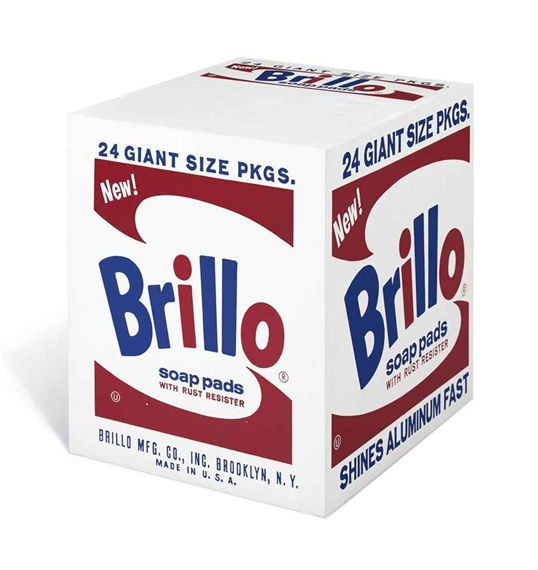
To review, read Subjective and Objective Perspectives.
1d. Define the categories of art, such as fine art, pop art, and decorative art
- What are some of the major kinds of popular art?
- What arts are usually categorized under the concept of fine art?
- How is decorative art different from popular and fine art?
Taking a broad view of the diversity of art practices, we can easily note that there is art that is "in the museums" (like paintings and sculptures), which is different from art that we may find "on the streets" (like graffiti or billboards) or even "on our persons" (as in the case of fashion) or in our homes (such as with embroidery and rugs). Similarly, art can be organized into the categories of fine art, popular art, or decorative art, depending on the roles that it fulfills along these social dimensions. A work of art can be considered important for cultural preservation and reflection (fine art), to be a kind of popular communication (pop art), or to serve as a handicraft that ornaments or decorates the useful items of our lives (decorative art).
Example:
Some artworks intentionally blur the lines between functional decorative and fine art sensibilities, producing objects that seem potentially usable in everyday contexts, but intended for ultimately only for gallery exhibition, such as Rodrigo Franzao's Mind I.
Andy Warhol's Brillo Box (discussed earlier) is a good example of pop art, which is fine art inspired by popular culture. So these categories of popular, fine and decorative arts can certainly overlap with each other and even cross-pollinate.

To review, read Artistic Categories.
1e. Recognize, describe, and evaluate artistic styles, such as naturalistic, abstract, and non-objective
- What does it mean to say that art may be "representational"?
- How much stylization might be apparent in art before it is considered to be abstract?
- What kinds of aesthetic experiences are produced by non-objective art?
We often expect art to depict something specific, as when a portrait needs to resemble a particular person. This is art's 'mimetic' role, which comes from the Greek word mimesis and refers to creating a representation of something. But we also know that art often takes great creative liberties in representation, and that many works impart all strong stylizations to the objects they represent. These artworks are called "abstractions", since their main goal is not to produce an "accurate" mimesis. Finally, we have all experienced works of art that do not resemble anything at all from our everyday experience. This kind of art may work with geometries, colors, or materials in ways that do not lend themselves to a clear interpretation. This kind of art is called "non-objective", because it foregoes any ties to recognizable objects of our experience.
Example:
Carles Delclaux's Nura is an example of abstract art, because it depicts recognizable objects in a highly stylized and thus non-naturalistic manner.
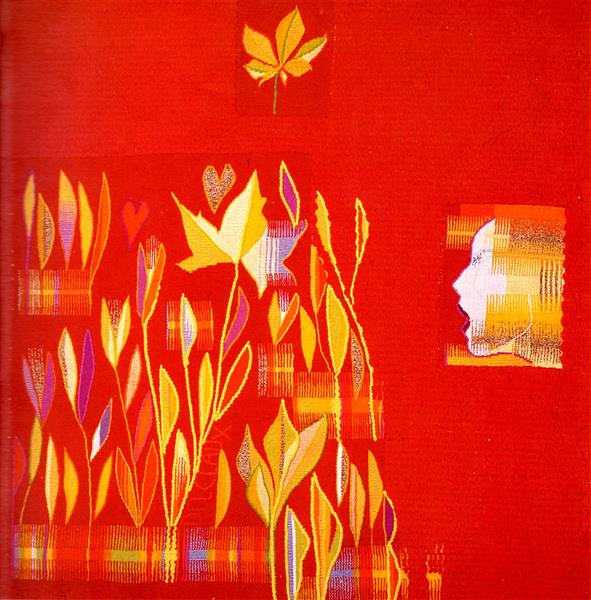
To review, read Artistic Styles.
Unit 1 Vocabulary
Be sure you understand these terms as you study for the final exam. Try to think of the reason why each term is included.
- subjective
- objective
- form
- content
- aesthetics
- fine art
- pop art
- decorative art
- abstractions
- non-objective
- non-naturalistic
Unit 2: Who Makes Art – Process and Training
2a. Explain the meaning of both form and content
- What are the components that belong to art's formal qualities?
- What shapes the meanings we obtain from encounters with artworks?
- How can we tell the difference between form and content in art?
Form and content are not just ways to analyze art, but are also used deliberately by artists to provoke specific responses in people. Artists might assume a common cultural background, so that the use of symbols will be instantly recognized by viewers. Or, they might use a specific processes to create the work to achieve a certain perceptual effect. Many artists are keenly aware of the material properties of the media they work with, and they understand both the objective qualities and likely subjective responses of the people who experience the work.
To review, read Form and Content.
2b. Describe the role of the critic
- How do critics shape conversations around art?
- What is the role of criticism in the understanding and appreciation of art?
- What informs the opinions of critics?
In the social world of art, critics play an important role in shaping and refining the concepts used to talk about art precisely and in service of contemporary debates about art. Curators create prose to unify specific exhibitions, and historians trace the influences on art across time and culture, but critics are the ones who hone the concepts and arguments used by those who take part in the discourse of art. Critics debate the relevance of art, its cultural status, its quality, its meaning, and other aspects that are important to the conversations that happen around the world of art.
Example:
Art criticism is not only the performed by critics. Artists can also be a part of the 'game' of art criticism. Gabriel von Max's painting Monkeys as Judges of Art, 1889, satirizes the role of the critic in the art world. What do you think the artist might be saying about art criticism?

To review, read The Artistic Process.
Unit 2 Vocabulary
Be sure you understand these terms as you study for the final exam. Try to think of the reason why each term is included.
- form
- content
- critics
- art criticism
Unit 3: How Art Speaks – Finding Meaning
3a. Identify the four levels of meaning in works of art: formal, subject, context, and iconography
- What are the qualities that make art iconographic?
- How does context shape the production and experience of art?
- What are some of the main genres or subjects of art?
The formal qualities of art relate to its material qualities and the way that we perceive them, and are inseparable from how we experience a work of art. Some art plays up its formal qualities so that they become more foreground than background – this kind of art might be called "formalist", because of how it demonstrates concern with the perceptual and material components in art.
What we have so far called "content" can be subdivided into other categories. Over spans of time, art is usually said to show evidence of genres (typical subjects of art), such as landscapes, portraiture, or street photography. In film, popular genres are sci-fi, romantic comedy and mystery.
Subjects organize traditions around making and influence our expectations of art. Art also has a context, which describes its interconnections with other artworks, or other aspects of society. For instance, some art is clearly made for religious spaces, and take religious themes and ceremony as its surrounding context to add to its meaning.
Art might also make strong use of common symbols, called iconography, which incorporate meanings that are widely shared in a culture into the artwork itself, where it will be recognized by those who can decode the symbols.
Example:
Art subjects are also called genres, and are ways that we can instantly identify what are artwork is interested in communicating since in any genre of art there will be many thousands of examples with which we may already have some familiarity. Kano Eitoku's Old Pine and Cherry Trees by Rocks is an example of landscape art, which is a very common subject or genre of visual art.
To review, read The First Level of Meaning: Formal.
3b. Define the term context, and discuss its essential role in finding meaning in art
- What are some of the main aspects of context that affect the making of art?
- How does one distinguish context-related features of art from other features?
- How does one become aware of the role of context in art?
Context itself can be a complex concept. It can relate to a whole range of factors, such as language, tradition, geography, world-views, religions, history, and the present circumstances. It can also reference local materials, available technologies. and access to art schools. Many things can have an impact on how an artwork is produced and experienced, and those factors that go beyond artists and artworks themselves fall under the heading of context.
Example:
An example of context playing a clear role in visual style is Street Art, which takes its inspiration from outdoor public places and urban environments. Richard Hambleton, for instance, made artworks that looked like realistic crime scenes to stun passersby:
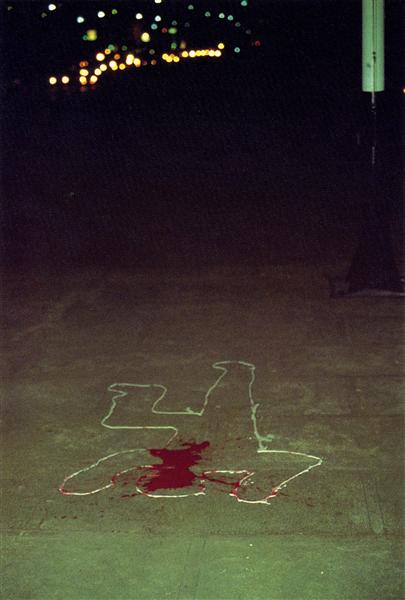
To review, read The Third Level of Meaning: Context.
3c. Describe the six critical perspectives: structural, deconstructive, formalist, ideological, psychoanalytical, and feminist
- What are some of the most common perspectives used in art criticism?
- What are some similarities that can be found in the main critical perspectives
- What are some of the main differences between critical perspectives?
Criticism of art is usually part of a certain intellectual tradition. Each of these traditions provides key concepts and methods of analysis. Structural criticism considers art as a system of elements that are composed together, like a language or set of repeating forms. This kind of criticism argues that artworks can be interpreted as being comprised of stable and recurring cultural codes that can be decoded by the art critic. Deconstructive criticism, on the other hand, plays up the differences in art that prevent it from forming stable structures of meaning. Formalist criticism analyses the material and perceptual attributes of art and its associated experiences. Ideological criticism seeks out evidence of power and social imbalances and sees art as potentially a way of perpetuating world-views which need to be challenged. Similarly, feminist criticism focuses on gender inequality and roots out the forms of patriarchy that appear in art. Finally, psychoanalytic criticism traces the patterns of conflict between consciousness and the unconscious, and seeks in art aspects of personality that are beyond subjective control and which subvert social personas.
Examples:
Feminist art will often highlight the role of the male gaze in constructing images of women. At the same time, it may employ images of the female body in a free-spirited and self-assured manner. Pauline Boty's painting It's A Man's World II is a good example of this vein of work which exhibits this kind of ambivalence, being both a celebration of women in their freedom of expressing themselves through their bodies, but also cognizant of how desire is organized for men in typical poses of women that are popular in mass media.

Surrealist art was a movement inspired by psychoanalysis, which saw dreams as 'the royal road to the unconscious" as Freud wrote. Psychoanalytic interpretations of art look for expression of psychological complexes in art, for instance caused by aspects of life that we repress in order to go about social life as productive citizens. These repressions, however, come out as forms of neuroses, which psychoanalytic therapy seeks to uncover in order to help the patient cope. Surrealists sought in psychoanalytic themes images that might provoke discomfort in the viewer, by making them contemplate aspects of their existence which in their daily life they might prefer not to think about.

To review, read Critical Perspectives.
Unit 3 Vocabulary
Be sure you understand these terms as you study for the final exam. Try to think of the reason why each term is included.
- formal qualities
- formalist
- genres
- subjects
- context
- iconography
- structural criticism
- deconstructive criticism
- formalist criticism
- ideological criticism
- feminist criticism
- psychoanalytic criticism
- Feminist art
- Surrealist art
Unit 4: How Art Works – The Elements and Principles of Visual Language
4a. Define and describe artistic elements and principles of design
- What is the difference between an artistic element and principle of design?
- What artistic elements can be combined to produce other elements?
- Which principles of design can be found across many kinds of media?
When we consider art's formal aspect (materials, the methods used to work them, and their perceptual effects), we make a general distinction between basic units (called elements), and the various principles for combining elements. Elements proceed from simple to complex: from point, to line, to planar shape, to mass, to figure/ground distinctions, and so on.
In a given work of art, these fundamental formal units relate to one another on a second, higher level. They are arranged according to principles of design, such as balance, repetition, emphasis, unity, variety, and so on. The key point to understand is that there is a fundamental conceptual distinction between simpler formal elements themselves, and the general rules or patterns of how they are combined, which are called the principles of design.
Example:
This sculpture's aesthetic effect depends on the use of the elements of Mass, Space and Texture, and the principles of Balance, Repetition and Proportion.
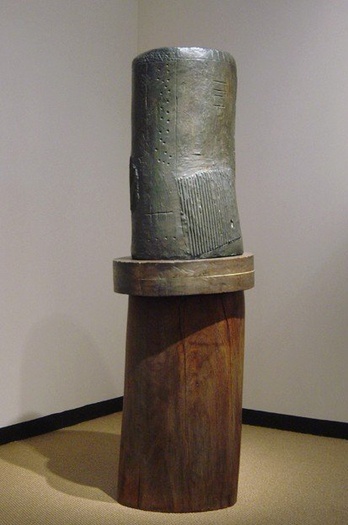
To review, read subunits 4.1 and 4.2.
4b. Compare and contrast artworks from different cultures using the language of art
- What aspects of art can be compared across cultural contexts?
- What are the ways that culture might influence art's creation and experience?
- Why does criticism compare art across cultures?
Comparative analysis of art carefully looks for similarities and differences in similar art forms across different cultures. For example, you might compare the art on temples in Hindu and Buddhist cultures, or between Christian churches and Jewish synagogues. Any cultural artefact that can be found in a variety of cultural contexts can be analyzed for their similarities and differences, such as textile patterns, paintings, sculptures, or films.
At a straightforward level, you can make verifiable statements about formal qualities (materials and methods used or their perceptual effects). You might then move beyond this and seek patterns, such as what might occur when one culture 'influences' another though trade or migration. You might even claim to find common 'archetypes' in image and narrative artefacts from a wide diversity of cultural sources. In any comparison and contrast, it is important to remain grounded in evidence and not leap to conclusions that may be affected by your own personal or cultural biases.
To review, read subunit 4.3.
Unit 4 Vocabulary
Be sure you understand these terms as you study for the final exam. Try to think of the reason why each term is included.
- elements
- point
- line
- planar shape
- mass
- figure/ground
- principles of design
- balance
- repetition
- emphasis
- unity
- variety
- cultural artefact
Unit 5: Artistic Media
5a. Identify and describe specific characteristics of the media that artists use
- What are the main kinds of media used in drawings and paintings?
- What are the main kinds of representation found in sculpture?
- How does time-based media differ from traditional spatial media, such as drawings and sculpture?
2D art can be broadly defined as being comprised of either wet or dry media. Watercolor, for example, is a wet media, while graphite is a dry media. Both wet and dry media can be used to create imagery specific to 2D forms.
3D media, such as sculpture, can be produced by additive or subtractive means. Additive means are when the artist lumps materials together, as when working with clay. Subtractive means are when the artist removes material to create a form, such as by carving and chiseling away at a stone sculpture.
Other forms of 3D media involve collaboration among artists, such as with festival spaces like Burning Man or with performance-based works. Installations activate large spaces by treating them as compositional zones that defy other categorizations like architecture or interior design.
Example:
This work by Pierre-Paul Prud'hon combines chalk and charcoal on paper.
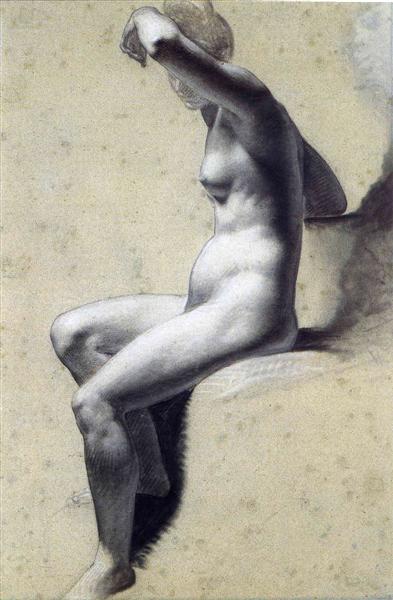
To review, read subunits 5.1 and 5.3.
5b. Explain how the advance of technology affected art practices
- What are some of the new forms of art that emerged from key technological developments?
- How do artists respond to the introduction of new technologies?
- Why do new technologies not replace the use of older technologies in art?
Historically, every new technology that became capable of producing images, sounds or representations were at some point used artistically, whether used widely (as in photographs) or more experimentally (as with analog video synthesizers, or air raid sirens in Futurist music compositions). As new media art introduced, it is a common pattern that they are used in the style of the old media. For instance, today we talk of 'web pages' even though the World Wide Web is not made up of paper. The web is full of pages because the dominant medium before the web, the book, was full of pages. The first photographic portraits looked just like painted portraits, and so on. Gradually, however, creative people begin to notice the unique affordances of new media technologies and eventually leave behind simple imitation of old styles in the pursuit of new expressive effects unique to the new media.
To review, read Early Development.
5c. Explain the effect photography had on traditional artistic media
- How did photography affect portraiture?
- How did painters respond to the new medium of photography?
- How did painting styles change in response to photography's increasing popularity?
All new technologies that make their way into art enter a crowded field of other practices and traditions. Photography is interesting to study because it is a relatively new medium (originating in the 19th century) and so it is relatively easy to view and understand the changes it wrought. For one, photography made portraiture, which was very expensive to produce, accessible to the larger population, and many photographic portraits emulated the painting styles. Photography also freed painters to do more things with paint than just copying reality, which opened up new avenues toward abstraction and non-objective art. Photography also did much to change or challenge the notion of art as a precious object – since photographs could be reproduced by the thousands or even millions, they changed the status of art from being thought of as unique works to a different notion of art as something that could even become commonplace. It is also important to point out that further investigations into photographic technologies, such as attempts to reproduce illusions of movement, led to new photo-based media such as film and video.
Examples:
Portraiture was one of the most popular uses of painting, and photography made it more accessible to a wider population.


To review, read Affect on Other Media.
5d. Differentiate between two-dimensional and three-dimensional media
- What are the main differences between 2D and 3D artistic media?
- How is depth rendered in 2D media?
- What forms of 3D media also dynamically change in time?
No painting or drawing is 'purely' two dimensional, since all surfaces have a thickness and 2D planes are in fact a geometric abstraction. However, in 2D or planar-surface-based art, the thickness of the medium is of no or very little importance. With 2D art, we only pay attention to the image rendered on the surface of the medium (paper, canvas, wall, etc.) in its height by width aspect ratio. With 3D art, depth is added to height and width and most importantly, it matters for the creation and reception of art. Whether depth is used to cut a stone figure against its background material, or to arrange artists in space in a work of performance art, or objects in a room as in installation art, all three dimensions of physical space are activated in 3D art in a way that is not true of 2D art.
To review, read subunits 5.1 and 5.3.
Unit 5 Vocabulary
Be sure you understand these terms as you study for the final exam. Try to think of the reason why each term is included.
- wet media
- dry media
- additive means
- subtractive means
- photography
- 2D art
- 3D art
Unit 6: Architecture
6a. Explain how the form of architecture affects the use of a structure
- What impacts the ways that works of architecture are built and how they appear?
- What are typical human functions for architecture to support?
- What have been some of the main technologies that influenced architectural style?
Since buildings serve to support human functions, their forms will call forth different approaches to the design of structure. Cathedrals, for instance, required tall ceilings to maximize outside light penetrating the interior spaces in order to create a heavenly presence, which in turn required new inventions like vaulted ceilings and flying buttresses. Central transportation stations built with iron trusses and skylights could accommodate many tracks and trains for the thousands of passengers who used them on a daily basis, and whose new, busier lives involved a need for more frequent travel between cities. The forms of architecture typically serve the functions asked of it, and designers seek out the optimal structures that ultimately support the function as well.
To review, read Methods and Materials.
6b. Describe traditional and modern styles of architecture and the effects of the Industrial Revolution on architecture
- What are some ways that architecture changed when comparing structures built before and after the Industrial Revolution?
- What were some of the main techniques for making buildings before the Industrial Revolution?
- What were some of the main technologies introduced by the Industrial Revolution?
The Industrial Revolution brought with it the ability to mass produce components for buildings, including new possibilities for steel-based frames and concrete which could radically increase the scale of built structures. Such buildings are inherently of a different kind from those built out of stone or wood and assembled with much less technological apparatus. Steel and reinforced concrete meant that spans could be larger, loads could be heavier, and more forceful stresses withstood. It also meant that traditional styles of ornament and decoration were often deemed unsuitable by contemporary architects and designers, who wanted to full embrace the new materials and methods and not stay tied to forms based on much earlier technologies.
To review, read Architecture and the Industrial Revolution.
6c. Explain how architecture acts as a reflection of culture
- What are some examples of buildings that show influences from different cultures?
- What are some examples of buildings that have features that can be traced to a cultural factor?
- What were some of the ways that the cultural interests of architecture changed in the 20th century, as was manifest in various styles?
When we travel to other countries, it is hard not to notice how buildings change so much, based simply on our having relocated ourselves geographically. The different buildings we see across the world in different social contexts point to the varied cultural backdrops against which these buildings were created. While general functions might be similar – for worship, military defense, education, work, or housing – the uniqueness of cultures means that architecture will find unique forms that are well-suited to the cultural environment and which distinguishes these forms from those produced elsewhere.
Example:
Modernist architects rejected the use of ornament and decorative elements based on past historical styles. Rather, they wanted to embrace contemporary materials and methods and create a style dissociated from the past and which addressed the present. A popular Modernist idea was that homes should be like "machines for living".

A form such as the cathedral was based on the idea of creating a great sense of height and letting in lots of colorful light in order to provoke spiritual contemplation and awe. Here the form's aesthetics is grounded in Christian practices of worship and in Catholicism in particular (relative to later Protestant movements), religious buildings were meant to possess a sensual grandeur to inspire the faithful and create a strong sense of ceremony.
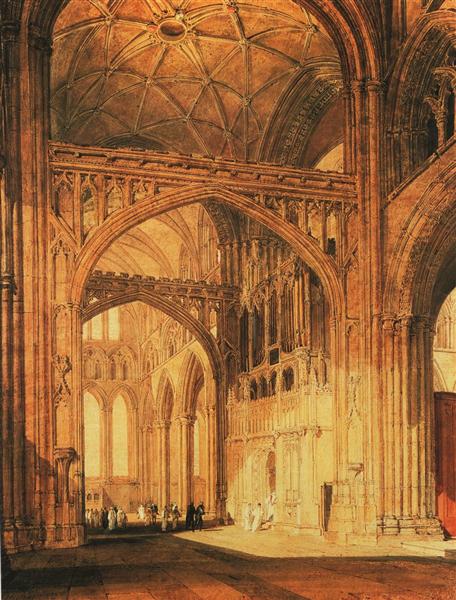
To review, read Cross-Cultural Influences on Architecture.
6d. Describe how new "green" technologies are changing architecture and design
- What are the main kinds of building systems and functions addressed by sustainable technologies in architecture?
- What are some of the main technologies used in green architecture?
- What examples can you think of which are good examples of green design in architecture?
All buildings are systems. We might think of them as 'structures' or 'offices' or 'homes,' but they support human functions through assembling together multiple specific functions that address a variety of different human needs. Typical systems which make up a building include heating, cooling, lighting, ventilating, and powering, and might also include other systems such as recycling rainwater, or supporting a living roof. Each of these systems has associated with it methods and technologies that can be traced back to the very origins of architecture. However, most of these systems would be considered as unsustainable in today's more ecologically-informed era. Green or sustainable design looks at new ways to provide the same kinds of traditional building systems with new approaches that minimize harmful environmental impacts.
To review, read Green Architecture.
Unit 6 Vocabulary
Be sure you understand these terms as you study for the final exam. Try to think of the reason why each term is included.
- forms
- functions
- Industrial Revolution
- cultural environment
- modernist architects
- aesthetics
- green/sustainable design
Unit 7: Our World – Nature, the Body, Identity, Sexuality, Politics, and Power
7a. Describe how visual information is a source of knowledge and explain how this is reflected in works of art
- What kinds of knowledge about the world might be found in visual representations?
- How might we uncover clues in art that refer to the representation of self?
- What are the various kinds of identity that can be represented in art?
We can think of artwork as sometimes being loaded with 'clues' which it is our job to uncover in order to piece together a story as to the artwork's meaning. We can derive knowledge from art, whether that knowledge is about the world or ourselves. Such knowledge can bear a close resemblance to sensory experience (such as a photograph based on similar optical principles as the eyes), or be seemingly highly abstract, as when patterns of DNA sequences are used as a new kind of contemporary portraiture of the self. It is part of our role as experiencers of art to come to grips with the kinds of knowledge that can be obtained in works of art.
To review, read sections 5.2 and 5.4 of Meaning in Art.
7b. Explain how the use of animals and other natural phenomena as subject matter in art offers clues to cultural differences
- How do scientific visualizations differ from other kinds of art?
- What are some of the ways the depictions of animals and nature differ across cultural contexts?
- How can the Greek concept of mimesis be applied to representations of animals and nature in art?
Nature, and the objects of nature (landscapes, animals, flora) have been a source of artistic inspiration and subject material as far back as can be traced historically, for instance to the animals depicted in cave paintings many thousands of years ago. Such depictions of natural subject matter can range from highly idealized and stylized imagery, such as when an animal represents a god or a force of nature, to a very different kind of aesthetic treatment when used in scientific contexts as illustrations grounded in accuracy of representation.
For example, see this work by Albrecht Dürer.

To review, read Nature.
7c. Explain how political art uses nature, the body, identity, sexuality, politics, or power as a public reflection on these issues
- What are some examples of art addressing major political events unfolding in history?
- How have some artists approached themes of sexuality and gender in their art?
- What are some examples of artists being interested in the expressive potential of the human body?
Artworks are often grounded in themes, which are generalizations about social life about which artists may want to make particular statements, whether their aims are to challenge or borrow from the thematic material. In social discourse, debates rage about sex and power, politics and violence, nature and the body, and artworks take up creative positions in these spaces of the public contestation of ideas.
To review, read Politics, Conflict, and War and Peace.
Unit 7 Vocabulary
Be sure you understand these terms as you study for the final exam. Try to think of the reason why each term is included.
- knowledge
- idealized imagery
- stylized imagery
- themes
- statements
Unit 8: Other Worlds – Myths, Dreams, and Spirituality
8a. Explain art in terms of ideas of the spirit
- What are some of the differences between art found in the world's major organized religions, and its appearance in traditional ritual and ceremony?
- What are some of the main differences between the art of Western and near-Eastern religious religions, such as Christianity and Islam?
- What are some of the main features of Buddhist art?
We can make a general distinction between the major organized religions of the world, which are relatively few in number – Christianity, Buddhism, Islam, or Judaism, for example, which are all associated with globalized identities and hierarchical social institutions – and the myriads of rituals and ceremonies that are typically unique to much smaller and more diverse tribes or bands and which can trace their beliefs and practices back for millennia. Whether 'religious' or more generally 'spiritual' in character, artworks that express this facet of human existence aim to invoke ultimate questions of human nature or indeed the nature of the cosmos in which we are ultimately embedded.
To review, read Spirituality.
8b. Explain art as a form of myth
- What is a myth, and why do they continuously appear in art?
- Why do the myths of antiquity (such as in ancient Greece) appear in later art, such as in Europe during the Romantic period?
- What are some examples of contemporary myth-making in popular art?
'Myth' is derived from the Greek word mythos, which means story. All cultures have as their most ancient historical backdrop a collection of stories, sometimes called folk tales or heroic epics, which helped to define cultural identity at a grand scale across space and time, for instance by tying peoples to territories and current events to the old creation myths. Myths, legends, stories and songs are retold to highlight the more durable features of human character and general patterns of life that recur across the generations.
Examples:
Myth in art may either be contemporaneous or retrospective. In other words, some works of art are from the time that the myths were still widely in everyday social use. In much later times, myths might be associated with classical periods as artists look back to mythical stories and imagery for their value at speaking to universal themes. This retrospective use of myth may sometimes take the form of nostalgia (e.g. for classical times) or idealism (venerating the art and stories of the past for their high quality and bestowing esteem upon them).
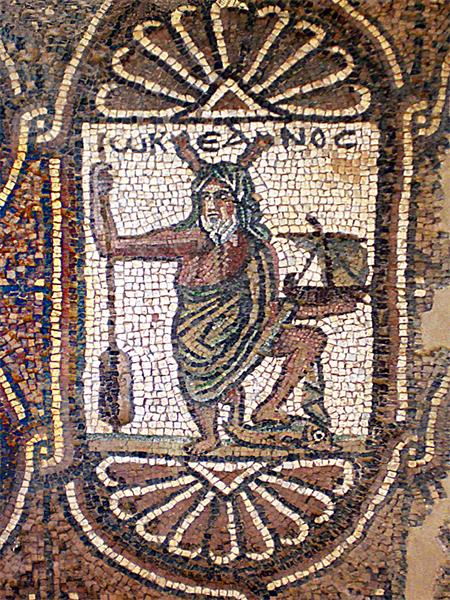
To review, read Myths.
Unit 8 Vocabulary
Be sure you understand these terms as you study for the final exam. Try to think of the reason why each term is included.
- rituals
- ceremonies
- religious
- spiritual
- myth
- contemporaneous
- retrospective
- nostalgia
- idealism
Unit 9: Art in Time and Place – The Western World
9a. Associate different artistic styles with specific geographies, eras, beliefs, and historical events
- What are some of the features of art that resulted from cultural beliefs in the afterlife?
- What are some aspects of art as it developed in Renaissance Europe?
- What kinds of cultural influences combined in art created along the Silk Road?
Ideas about art change along with general conceptual evolutions in the history of ideas. What artists in the Renaissance focused on, such as with new discoveries around rendering the illusion of perspective, will be different from what interested Romantic artists – concerned as they are with the expression of self and human nature as could be found in classical myths. New technologies, such as photography, might free painters from the disciplines of always mirroring reality, and thus open up creative space for new approaches, such as those of Impressionism, Cubism and Expressionism. The Futurists were obsessed with war and technological change, while the Fauvists thought art had become too gloomy and was in need of a lighter, and brighter, emotional spirit. This unit spans tens of thousands of years, beginning with the cave paintings – whose original meanings we can only guess at – to today's postmodern era.
9b. Link artworks and artists based on historical and geographic contexts
- Who are some of the artists associated with Impressionism?
- What are some of the characteristics of artworks associated with Expressionism?
- What were some of the identifying features of Byzantine art?
History and Geography are the human aspects of Time and Space. Many museums of the world arrange the rooms where artefacts are displayed by geography – the Art of Japan, or the Art of Sumeria, or the Art of Mexico, for instance. As we wander these museums, we come to associate art with its areas of origin. The historical progression of creative practices is less easy to build into museum design, perhaps because a timeline – which indicates the linear movement of events that progress in only one direction in time – does not translate as well into architectural form as does geographic allocations of museum collections to museum rooms. This unit will help you to form the main associations of key artworks with historical periods and the areas of the globe where the works were originated.
Examples:
Viewing art historically allows you to trace ideas sometimes across even thousands of years. For instance, the Roman innovation of the arch was not just a structural invention, but also a cultural reference for architecture during the Romanesque period (6th to 11th century) when Roman forms were rediscovered in the Middle Ages. Much later still, postmodern architects would mine Roman forms for their expressive value as kitsch, or light-hearted or even frivolous and playful cultural reference.
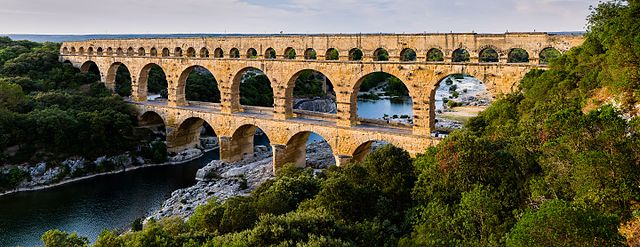


Unit 9 Vocabulary
Be sure you understand these terms as you study for the final exam. Try to think of the reason why each term is included.
- Renaissance
- Romantic artists
- Impressionism
- Cubism
- Expressionism
- Futurists
- Fauvists
- postmodern era
- artefacts
- historical periods
- Romanesque period
- Middle Ages